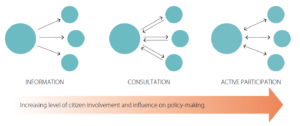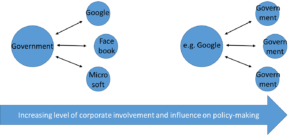Global trends in governmental innovation practices
The purpose of this blog-post is to extend Chief Information Officer (CIO) for the state of California Chris Cruz’s initiated discussion about the governmental innovation practices to a global level. I believe my effort provides the reader with a deeper understanding about (a) a variety of innovative actions, (b) their reasons and (c) future development patterns. I conclude this post with an open question about these patterns and roles of governments, citizens and corporate big-data holders.
The insights provided by Chris Cruz inspired me to take a step further in exploring the similar to described governmental initiatives on a global scale. The recent OECD (2017) report called “Embracing Innovation in Government. Global Trends” provided me with an extensive showcase of 10 international examples to supplement the insights of Cruz’s discussion. Further, I will go through the three most interesting ones:
1.Governmental and community cooperation to use of big data to produce real-time flood maps in Jakarta, Indonesia (OECD, 2017; 16-22).
Greater Jakarta is known for its natural disasters and floods that are a source of great concern for both, city officials and residents. The local government supported the initiation to gather the real-time flood data with the help of a tool “that combines data from hydraulic sensors and civic applications, including via Twitter, to produce real-time flood maps.” (OECD, 2017; 4). This cooperation provided the best results for both, residents and officials to monitor and anticipate the natural disasters.
2. Governmental initiative to combine and utilize the citizen driven big data to map the complex public transportation routes in Mexico City, Mexico (OECD, 2017; 40-42).
Mexico City has one of the largest and because of that, most complicated public bus systems in the world. Neither city officials nor residents had updated information about the variety of routes operated by different bus operators. To solve this problem the city launched an interactive crowdsourcing game aimed at mapping the different routes and combining them all into one centralized database. As a result, over 4000 city residents played the game while traveling by busses providing the city officials with the real-time GPS coordinates indicating the bus routes within the city.
3. Governmental support of community effort in identification of factors that influence well-being in Santa Monica, CA (OECD, 2017; 66-69).
Despite its economic well-being the city of Santa Monica was known for a succession of violent youth tragedies starting from suicides and finishing by college shootings. The shared efforts of Santa Monica city and community resulted in collection and analysis of big-scale data that identified the factors influencing well-being. The results of this project provided local decision makers with increased understanding of factors that need to be taken into account in order to prevent misfortunes and increase the general well-being of city’s inhabitants.
These cases is just a snapshot of global efforts to overcome existing government-citizen interaction barriers, promote inclusiveness, build trust-based relationships and grow an innovative culture. The central goal of all of these initiatives is to encourage the involvement and active participation of citizens in development of personal and societal well-being. The following picture best illustrates these efforts:

Picture 1: Desired development of government-citizens cooperation (Source: OECD, 2017; 44).
Google and many other innovative companies (see e.g Lazer, Kennedy, King & Vespignani, 2014; McAfee & Brynjolfsson, 2012) have developed the “active participation” level of cooperation with citizens far beyond governments. This provides such companies with a mediator role that has a most reliable data and abilities to influence governmental decision making. I suggest that this trend will further develop according to the following illustration:

Picture 2: The evident development of corporate-government cooperation.
It is evident, that cooperation with corporate stakeholders provides government officials with solutions that are easier to summarize, handle and negotiate. The role of Big-data and entities that possess it is going to increase. This is a reason why many governments restrict the possession of data-collection and storage centers outside of own borders (e.g. EU, Russia). It remains to be seen how governments will balance between citizens’ active participation and corporate involvement. How do these pictures will look like in 10 or 20 years?
References:
Lazer, D., Kennedy, R., King, G., & Vespignani, A. (2014). The parable of Google Flu: traps in big data analysis. Science, 343(6176), 1203-1205.
McAfee, A., & Brynjolfsson, E. (2012). Big data: the management revolution. Harvard business review, 90(10), 60-68.
OECD (2017) Embracing Innovation in Government Global Trends, http://www.oecd.org/gov/innovative-government/embracing-innovation-in-government-global-trends.htm
8 comments on “Global trends in governmental innovation practices”
Comments are closed.


Thank you for your insightful essay about government usage of cutting edge technologies and especially data mining techniques. I wonder whether governments around the world will be able to keep up with the latest technologies or whether they will increasingly outsource software and hardware development to technology companies. One company that has been at the forefront of applying data mining techniques to solve government problems is Palantir (palantir.com, https://www.ft.com/content/926af768-1a4c-11e5-a130-2e7db721f996?mhq5j=e1, http://www.economist.com/node/21554743). It received funding from the CIA, and has been cooperating closely with the NSA, CIA, and FBI (https://www.forbes.com/sites/andygreenberg/2013/08/14/agent-of-intelligence-how-a-deviant-philosopher-built-palantir-a-cia-funded-data-mining-juggernaut/#b858b0f77852). They helped the government track down Osama Bin Laden, find housing for homeless people, and identify the most effective aid distribution methods after typhoon Haiyan (http://www.mercurynews.com/2016/10/04/palantir-using-big-data-to-solve-big-humanitarian-crises/, https://www.palantir.com/disaster-preparedness/). Do you think over the next 20-30 years world governments will increasingly rely on innovative companies such as Palantir, or will they choose to create strong tech teams within the government?
You touched very interesting and important point; how to determine the innovativeness of a company? Moreover, whose interests this innovativeness is meant to serve? One critical example of such innovativeness could be WikiLeaks. It is surely innovative and provides the most intimate information about everyone (including power holders). However, is this innovation used constructively? Who decides upon that? Is it a government, corporation, community or individual?
This blog shared three examples of how the government uses big data and real-time data to improve the safety, sense of happiness, and public transportation in the city. As the technology progresses, the government-citizen communication also needs to be changed. Even the government is often slow at changing, they still need to find a better way to adjust to the new information age. In example two, only 4,000 people participated in the game. Compare to the population who took public transportation daily, this number is quite small. I agree with that this type of new communication between citizens and the government requires active participation. It was a great post overall!
Very interesting notice from your side! I did not consider the scale of the city when writing about the project in Mexico City. It surely looks very small when compared to the actual amount of people using busses there. However, I believe that regardless of comparatively small amount of participants, the initiative was successful. First, they accomplished their goal of mapping the bus routes. Second, it was the first trial to do such project on such a large scale. I am sure that organizers have learned their lessons from this experience gaining the expertise for scaling the following projects. I am sure we will hear from them more very soon.
I really enjoyed the three examples you chose to represent how governments are incorporating big data into their communities. I believe that this shows the rise of big data needing to be incorporating in governments in order to help benefit the public. Like you mentioned at the end of your post, big companies like Google, Facebook, and Microsoft have overcome the barriers that exist between the government and civilian. Now and in the future, I believe that these big data companies will be the ones with the real power to control society. Overall, this was a really informational and thoughtful post. Thank you for sharing.
Yes. The growing power of big data companies… You touch a very sensitive topic here. It is so sensitive and so relevant to all of us, that they made a recent movie about it in Hollywood. Have a look at the “The Circle” (2017) with Emma Watson and Tom Hanks. How would you classify it – fiction OR reality?
Great post, and very insightful comment. I agree that tech giants such as Google, Facebook, and Microsoft will have increasing control in society, but I am worried about what the role of governments will be in the future. Genreally speaking publicly listed companies are maximising shareholder returns, whereas governements should focus on maximising public good. Especially Natasha’s illustration in Picture 2 is concerning, and the only way to improve the negotiating position of the governments is for them to collaborate closely to formulate universal policies e.g. for cyber security and data sharing. Perhaps it is time for a “Paris agreement” in the field of information technology.
Great post ! I think it is interesting to notice that governments have a crucial role to play in the enforcement of Big Data solutions for national issues. Indeed, you provided many examples of successful implementations of these solutions by the governments.
I do believe that in many cases governments should give a boost to such innovations, but they are often shy because of the high investments needed. I think that a good strategy should be to back some private initiatives at first, before trying to implement an innovation at a larger scale. For instance, the UK government backed a project between an hospital and IBM to develop a “cognitive hospital”. If the result is positive it should set a trend for the coming years… [https://www-03.ibm.com/press/uk/en/pressrelease/49725.wss]